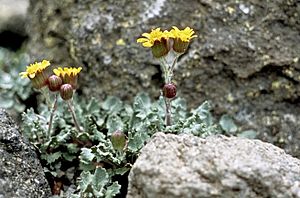Packera franciscana facts for kids
Quick facts for kids Packera franciscana |
|
|---|---|
 |
|
| Conservation status | |
| Scientific classification | |
| Synonyms | |
|
Senecio franciscanus |
Packera franciscana (also called Senecio franciscanus) is a very rare flowering plant. It belongs to the aster family, which includes sunflowers and daisies. People often call it the San Francisco Peaks groundsel or San Francisco Peaks ragwort.
This special plant only grows in Arizona, United States. You can find it only on the San Francisco Peaks in Coconino County. It is a federally listed threatened species in the United States. This means the government protects it because it is at risk of disappearing. Outdoor activities in its home area threaten this plant.
Contents
What Does the San Francisco Peaks Groundsel Look Like?
Packera franciscana is a small perennial herb. This means it is a plant with soft stems that lives for more than two years. It grows only a few centimeters tall. It has rhizomes, which are underground stems that help it spread.
Its stems are purple or have a purple tint. They are covered in soft, woolly fibers. The leaves at the bottom of the plant look like a lyre (a small harp). They can also be somewhat oval. These leaves are up to 2 centimeters long and 5 centimeters wide. They have ruffled edges and purple undersides. Leaves higher up on the stems are smaller and sometimes divided into parts.
Flowers and Fruit
The plant produces one or a few flower heads. These heads grow together at the top of the woolly stem. Each flower head has hairy purple phyllaries around it. These are like small leaves that protect the flower. Inside, there are 8 or 13 yellow ray florets. These are the petal-like parts of the flower, and they can be up to a centimeter long.
After blooming, the plant produces a fruit called an achene. This is a small, dry fruit that contains one seed. The achene has a pappus on top. A pappus is a tuft of hairs that helps the seed float away in the wind. It is about half a centimeter long. The plant usually blooms from August through October.
How Does the Plant Reproduce?
Packera franciscana can reproduce in two ways. It can make seeds through sexual reproduction. However, it more often reproduces vegetatively. This means it grows new plants from its rhizome (underground stem).
Many plants grow in wide patches. These patches are made up of several cloned stems. A clone is an exact copy of the parent plant. Some plants, however, grow alone. These solitary plants have sprouted from a seed.
Where Does the San Francisco Peaks Groundsel Live?
Packera franciscana grows on two of Arizona's San Francisco Peaks. These are Humphreys Peak and Agassiz Peak. It also grows in the saddle (a low area) between them. Humphreys Peak and Agassiz Peak are the two tallest mountain peaks in Arizona.
This plant lives in a special alpine tundra habitat. This habitat is found high up on the mountains. It grows in the volcanic talus (loose rocks) on the mountain slopes. This area has very little other vegetation. It is located above the tree line, where trees cannot grow. This is the only alpine zone in Arizona. The plant grows at elevations between 3200 and 3800 meters. Most of the plants are found between 3525 and 3605 meters high.
The plant seems to be well-suited to living in a fellfield habitat. This habitat is made of unstable talus (loose rocks). Its long rhizome and adventitious roots help it survive. Adventitious roots are roots that grow from parts of the plant that are not usually roots. These roots might not be anchored to a stable surface. If rocks tumble, a root might break. Pieces of the root can then grow into new plants through cloning. Even though the plant lives in a small area, it is common in its local spots.
What Threatens This Plant's Habitat?
Many things threaten Packera franciscana. These include fun outdoor activities like mountaineering, hiking, and skiing. The expansion of the Arizona Snowbowl ski resort was likely to harm the plant's home. However, construction was stopped after a legal challenge.
People are working to protect this plant. They have built trails away from where the plants grow. They have also closed some alpine areas to recreation. You now need a permit to visit these sensitive spots. This plant lives high on mountaintops. It may suffer during climate change. This is because it cannot move to higher or colder places as the Earth gets warmer.
Images for kids



